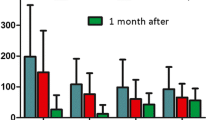Abstract
Purpose
The clinical efficacy of intraductal radiofrequency ablation (RFA) with Habib™ EndoHPB catheter, a newly developed intervention for malignant extrahepatic biliary obstruction, remains uncertain. The aim of this study was to investigate the clinical efficacy of intraductal RFA.
Methods
Data from 71 patients with extrahepatic distal cholangiocarcinoma were retrospectively analyzed. The study patients were divided into RFA and control groups. The RFA group had undergone percutaneous transhepatic intraductal RFA with a Habib™ EndoHPB catheter, followed by placement of covered or uncovered biliary self-expandable metallic stents (SEMs) whereas the control group had undergone percutaneous transhepatic covered or uncovered SEMs placement. Procedure-related complications, stent patency, patient survival, and postoperative serum bilirubin concentrations were compared between the two groups. The Functional Assessment of Cancer Therapy-Hepatobiliary (FACT-Hep) questionnaire was administered to evaluate functional status, improvement in clinical manifestations, and quality of life.
Results
The RFA group had a longer median stent patency than the control group (p = 0.001 for uncovered SEMs placement). Higher functional well-being, hepatobiliary-specific cancer subscale, Trial Outcome Index, and total FACT-Hep scores were observed during post-procedure follow-up in the RFA group. However, median survival did not differ significantly between the two groups (p > 0.05).
Conclusions
Prolongation of stent patency and better functional status and quality of life, which are all important clinical endpoints, were observed in patients treated with intraductal RFA. Prospective randomized controlled clinical trials are necessary to further investigate the clinical efficacy and long-term benefits of intraductal RFA.








Similar content being viewed by others
References
Zacharoulis D, Lazoura O, Sioka E, Potamianos S, Tzovaras G, Nicholls J, et al. Habib EndoHPB: a novel endobiliary radiofrequency ablation device. An experimental study. J Invest Surg. 2013;26(1):6–10. doi:10.3109/08941939.2012.681832.
Wu TT, Li HC, Li WM, Ao GK, Lin H, Zheng F, et al. Percutaneous intraluminal radiofrequency ablation for malignant extrahepatic biliary obstruction: a safe and feasible method. Dig Dis Sci. 2015. doi:10.1007/s10620-015-3547-6.
Dolak W, Schreiber F, Schwaighofer H, Gschwantler M, Plieschnegger W, Ziachehabi A, et al. Endoscopic radiofrequency ablation for malignant biliary obstruction: a nationwide retrospective study of 84 consecutive applications. Surg Endosc. 2014;28(3):854–60. doi:10.1007/s00464-013-3232-9.
Mizandari M, Pai M, Xi F, Valek V, Tomas A, Quaretti P, et al. Percutaneous intraductal radiofrequency ablation is a safe treatment for malignant biliary obstruction: feasibility and early results. Cardiovasc Interv Radiol. 2013;36(3):814–9. doi:10.1007/s00270-012-0529-3.
Figueroa-Barojas P, Bakhru MR, Habib NA, Ellen K, Millman J, Jamal-Kabani A, et al. Safety and efficacy of radiofrequency ablation in the management of unresectable bile duct and pancreatic cancer: a novel palliation technique. J Oncol. 2013;2013:910897. doi:10.1155/2013/910897.
Li TF, Huang GH, Li Z, Hao CF, Ren JZ, Duan XH, et al. Percutaneous transhepatic cholangiography and intraductal radiofrequency ablation combined with biliary stent placement for malignant biliary obstruction. J Vasc Interv Radiol. 2015;26(5):715–21. doi:10.1016/j.jvir.2015.01.037.
Laquiere A, Boustiere C, Leblanc S, Penaranda G, Desilets E, Prat F. Safety and feasibility of endoscopic biliary radiofrequency ablation treatment of extrahepatic cholangiocarcinoma. Surg Endosc. 2015. doi:10.1007/s00464-015-4322-7.
Heffernan N, Cella D, Webster K, Odom L, Martone M, Passik S, et al. Measuring health-related quality of life in patients with hepatobiliary cancers: the functional assessment of cancer therapy-hepatobiliary questionnaire. J Clin Oncol. 2002;20(9):2229–39.
Yount S, Cella D, Webster K, Heffernan N, Chang C, Odom L, et al. Assessment of patient-reported clinical outcome in pancreatic and other hepatobiliary cancers: the FACT Hepatobiliary Symptom Index. J Pain Symptom Manag. 2002;24(1):32–44.
Li M, Bai M, Qi X, Li K, Yin Z, Wang J, et al. Percutaneous transhepatic biliary metal stent for malignant hilar obstruction: results and predictive factors for efficacy in 159 patients from a single center. Cardiovasc Interv Radiol. 2015;38(3):709–21. doi:10.1007/s00270-014-0992-0.
Davids PH, Groen AK, Rauws EA, Tytgat GN, Huibregtse K. Randomised trial of self-expanding metal stents versus polyethylene stents for distal malignant biliary obstruction. Lancet. 1992;340(8834–8835):1488–92.
O’Brien S, Hatfield AR, Craig PI, Williams SP. A three year follow up of self expanding metal stents in the endoscopic palliation of longterm survivors with malignant biliary obstruction. Gut. 1995;36(4):618–21.
Rossi P, Bezzi M, Rossi M, Adam A, Chetty N, Roddie ME, et al. Metallic stents in malignant biliary obstruction: results of a multicenter European study of 240 patients. J Vasc Interv Radiol. 1994;5(2):279–85.
Zacharoulis D, Tzovaras G, Rountas C, Poultsidis A, Katsogridakis E, Sioka E, et al. Modified radiofrequency-assisted liver resection: a new device. J Surg Oncol. 2007;96(3):254–7. doi:10.1002/jso.20770.
Author information
Authors and Affiliations
Corresponding author
Ethics declarations
Conflict of Interest
All authors declare that they have no conflicts of interest.
Ethical Approval
All procedures performed in studies involving human participants were in accordance with the ethical standards of the institutional research committee and with the 1964 Helsinki Declaration and its later amendments or comparable ethical standards.
Additional information
Wei-min Li—Co-first author.
Rights and permissions
About this article
Cite this article
Wu, Tt., Li, Wm., Li, Hc. et al. Percutaneous Intraductal Radiofrequency Ablation for Extrahepatic Distal Cholangiocarcinoma: A Method for Prolonging Stent Patency and Achieving Better Functional Status and Quality of Life. Cardiovasc Intervent Radiol 40, 260–269 (2017). https://doi.org/10.1007/s00270-016-1483-2
Received:
Accepted:
Published:
Issue Date:
DOI: https://doi.org/10.1007/s00270-016-1483-2




